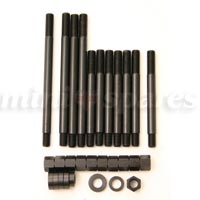
Performance orientated engines, particularly those utilising large over-bore sizes (i.e. 73.5mm), can suffer from premature head gasket failures because of the inadequate quality and performance from the standard head studs. Mini Spares has therefore produced a replacement kit to eliminate these problems. Read more

Modified to give maximum performance gain for cost.
Combustion chambers, inlet and exhaust ports extensively re-worked. Smoothed finish in ports - not mirror-finish polished - to minimise drag. Multi-angle valve seats in head. Super-quality MG Metro valves modified to increase airflow. Combustion chamber volume used to give slight static compression ratio increase over standard. Head mods employed greatly increase volumetric efficiency, boosting actual running (dynamic) compression ratio. Read more
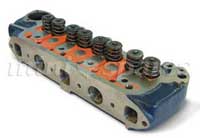
Modified to give maximum performance gain for cost.
Exhaust seats Latest spec inserts for lead free fuel Modified to give maximum performance gain for cost. Combustion chambers, inlet and exhaust ports extensively reworked. Stone-ground finish in ports promotes ultimate fuel atomisation. Read more
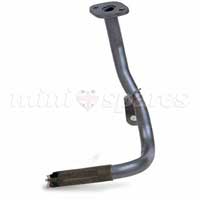
Oil pressure loss caused by oil surge can be experienced under hard cornering. To alleviate this it is essential to fit a centre oil pick-up pipe.Mini Spares' continual research and development program has seen advances in pick-up pipe design, replacing the original ancient design conceived by Abingdon ST some thirty-plus years ago. Read more
This flywheel is not balanced so should be before use, along with the prospective clutch assembly.
Before fitting the Mini Spares Ultra-light steel flywheel, carefully examine the crankshaft taper for any burrs or other protrusions caused by fret-welding of previous flywheels. All protrusions of any sort must be removed as they will cause incorrect seating of the flywheel which could, in turn, cause this fret-welding to occur and permanently damage both crankshaft and flywheel. A recognised method of ensuring correct fit is to use fine valve lapping paste to lap the flywheel on to the taper.
A good, correct fit will be confirmed by seeing an even grey finish over the whole of the taper on both components. The paste should then be thoroughly washed off using a strong cleaning solvent (such as cellulose thinners or brake cleaner). Read more
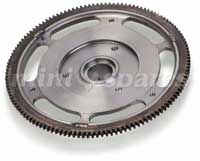
This flywheel is not balanced so should be before use, along with the prospective clutch assembly.
Before fitting the Mini Spares Ultra-light steel flywheel, carefully examine the crankshaft taper for any burrs or other protrusions caused by fret-welding of previous flywheels. Read more
Reduction of rotating mass releases more power to accelerate the car as the engine sees less weight to accelerate. Considering for a Mini that a mere 1lb reduction in the rotating mass of the flywheel causes a loss of accelerative weight to the tune of around 12lb - the benefits of rotating mass reduction are obvious. The C-AEG423 weighs some 4lbs less than the standard item.
To extend it's range of superior quality, light-weight steel flywheels, Mini Spares has produced this component to give the later model, SPi Mini owner the benefits from such weight saving. This component has the flywheel sensor reluctor ring machined into the flywheel itself. However, it is NOT compatible with the standard injection diaphragm/spring. Read more

This flywheel is not balanced so should be before use, along with the prospective clutch assembly.
Before fitting the Mini Spares light steel flywheel, carefully examine the crankshaft taper for any burrs or other protrusions caused by fret-welding of previous flywheels. Read more
This flywheel is not balanced so should be before use, along with the prospective clutch assembly.
Before fitting the Mini Spares light steel flywheel, carefully examine the crankshaft taper for any burrs or other protrusions caused by fret-welding of previous flywheels. All protrusions of any sort must be removed as they will cause incorrect seating of the flywheel which could, in turn, cause this fret-welding to occur and permanently damage both crankshaft and flywheel. A recognised method of ensuring correct fit is to use fine valve lapping paste to lap the flywheel on to the taper.
A good, correct fit will be confirmed by seeing an even grey finish over the whole of the taper on both components. The paste should then be thoroughly washed off using a strong cleaning solvent (such as cellulose thinners or brake cleaner). Read more

Previous rocker spacer kits offered by various A-series specialists have largely contained just three spacers in various forms and materials. They all had one thing in common though – they were inadequate. The issues revolve around two basic problems – the varied position of rocker post and head studs through factory machining tolerance and the variety of widths of rockers arms. Read more
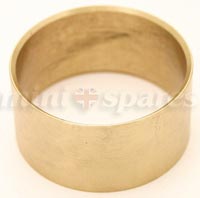
This bush is made to fit as many known 1275 primary gears - both helical and straight cut - as possible that use the original 22G109 type bush. There may be some exceptions where the manufacturer uses a slightly shallower bush housing Read more
Vertical rear moulding for the Estate and Traveller rear side windows.
14.4375” or 367mm With the double row channel grooves facing upwards. This is a side view elevation. This channel will require the ends to be cut exactly as above to the original angle of 20 degrees and the correct length as shown which ensures the best fitment. As the material is not the easiest to cut cleanly it is recommended that a new hacksaw blade or good quality snips are used and the channel grooves are packed with wood splints. Alternatively, you can use your old original sample as a template. 14A7631 – FRONT VERTICAL MOULDING HAS SQUARE ENDS, 340MM LONG Alternatively, use your old original sample as a template
Read more
(ROAD ROCKET) LARGE-BORE HEAD.
Modified to give maximum performance gain for cost. Combustion chambers, inlet and exhaust ports extensively re-worked. Smoothed finish in ports - not mirror-finish polished to minimise drag. Multi-angle valve seats in head. Super-quality MG Metro valves modified to increase airflow. Combustion chamber volume used to give slight static compression ratio increase over standard. Head mods employed greatly increase volumetric efficiency, boosting actual running (dynamic) compression ratio. Read more
Having applied Hi-Los and some smart 165/60/12 profile tyre shod12 x 5-inch ally rims, discussions get around to a subject that has cropped up a zillion times in the Knowledge, at shows, my e-mail address, etc. - just why does this combination cause the tyre to hit the front arch?
To be more exact - why does the tyre just rub, twang the plastic arch off, or foul the arch to the point of bending it? Even if the genuine, original fitment 'Cooper' alloy 12-inch rims are used with the 165/60/12 tyres? Well, it's all a question of alignment - either subframe to body or suspension to subframe. When trying to source/cure the problem, many folk have discovered that shim plates have been used between the front panel to subframe teardrop mounting and the subframe - and wonder if the car has been in an accident and been 'fudged', so could be causing the problem.
Read morePredominantly 13-inchers, but 12s as well, the main thrust of the questions being 'what do I need to do?'
This subject is a regular visitor to the message board and 'Knowledge' section of Mini Magazine for whom I write - fitting bigger wheels. Predominantly 13-inchers, but 12s as well, the main thrust of the questions being 'what do I need to do?' along with 'which wheel arch extensions will I need?' The answer has always been somewhat 'clipped' purely because of the space availability issues both in the magazine and on the message board, so something a little more detailed was required. Although the Mini suspension was designed around the use of 10-inch wheels with cross-ply tyres, a quick dash through history reveals that fitment of these bigger wheel sizes isn't a recent, 'modern' application. Read more

This valve spring set has been developed to fit standard sized top caps, and cope with fast road/rally rpm and high valve lifts, without crushing, of up to 0.495” without modifications when fitted to a cylinder head that has standard or near standard valve spring heights. However, where possible, it is always advantageous to correct and match the valve spring heights (measured from the spring seat in the head to the underside of the spring retainer cap), as these will vary particularly where new valve seats are cut. Read more
Material choices for guides are down to two distinct types - cast iron and bronze. Yes, cast iron. NOT steel as described in many adverts and by vendors.
Never have been, never will be. These are as fitted to the various A-series cylinder heads as standard in all applications. Cast iron is used because it is a very dissimilar metal from any used in valve manufacture - important to eliminate galling that causes seizure of the valves in the guides - is softer, yet resilient enough to wear well. Bronze, on the other hand, is a very general description as there are a variety of 'bronzes' used by various folk. In days gone by, the bronze base type used was 'PB1' (also known as 'Navy Bronze') - a phosphor-bronze alloy that was very orange in colour, and very soft, used primarily in race engines. Read more
Contemplating the discussions various discussions and lengthy correspondences on the subject of performance preparation, something filtered through to the surface. Tyres.
I've never covered the subject in any detail before, and it appeared that there's a distinct lack of even the most fundamental appreciation of what tyres are all about! In any competition discipline - or in fact any road-going situation as well - the tyres and control parameters used are so important to success, practically all the effort put into the chassis and suspension is to enable those four, relatively small (about the size of your average 'welly' foot-print) contact patches to give of their best. So something was desperately needed to address the situation. As I said, the ultimate goal is get those four small contact patches to give of their very best. Read more
The 'Gospel according to Calver' concerning all tuning carried out on any aspect of your car and therefore the most poignant sentence to remember when planning your campaign of modifications. 'Tuning should be a compromise between what is possible and what is necessary' Committing this to memory will increase the enjoyment and fun factor by having a car that can be driven very quickly yet have maximum reliability. After all, frustration, disappointment, and depleted funds have condemned more projects and race cars to the scrap heap than practically anything else. Read more

